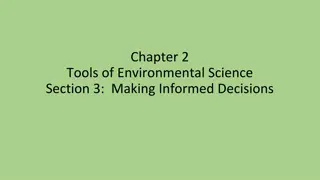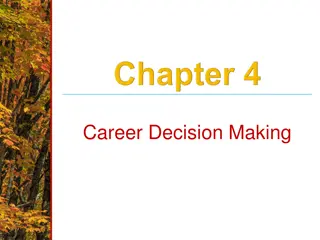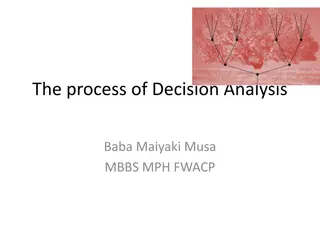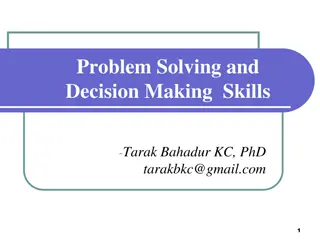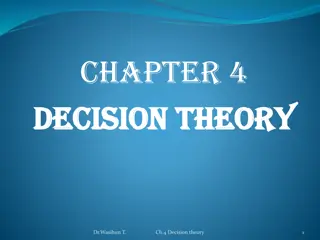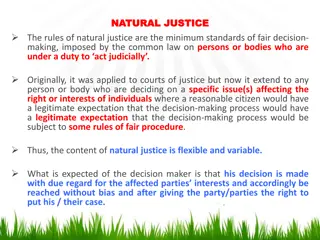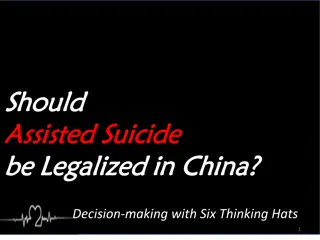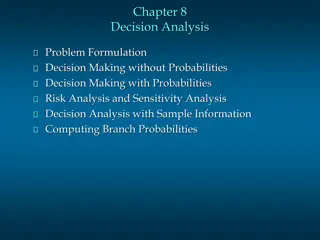
Decoding the Decision-Making Process: Key Steps and Strategies
Explore the intricacies of decision-making, from problem identification to outcome evaluation. Learn about the critical thinking skills and logical approaches necessary for making informed choices. Discover how contingency planning and establishment of decision-making criteria play essential roles in the decision-making process.
Download Presentation

Please find below an Image/Link to download the presentation.
The content on the website is provided AS IS for your information and personal use only. It may not be sold, licensed, or shared on other websites without obtaining consent from the author. If you encounter any issues during the download, it is possible that the publisher has removed the file from their server.
You are allowed to download the files provided on this website for personal or commercial use, subject to the condition that they are used lawfully. All files are the property of their respective owners.
The content on the website is provided AS IS for your information and personal use only. It may not be sold, licensed, or shared on other websites without obtaining consent from the author.
E N D
Presentation Transcript
DECISION-MAKING NUT 468 Spring 2017
Decision Making: Definition Logical stepwise approach used to make a choice between options to solve a problem, or to resolve a dilemma Some decisions are applied as a matter of habit, having made the decisions long ago and forgotten the reasoning behind them i.e. how to brush teeth, which hand to write with etc . Decisions were involved when those skills were being learned but are no longer relevant
THE DECISION-MAKING PROCESS
The Process of Making Decisions Contingency Planning: Anticipation of the need to make a decision sometime in the future and making the decision in advance so that it can be implemented in a timely manner at the time it is needed The choice of which route to take to work (one is the short one, the other is the longer one when traffic is expected on the short one, then the driver automatically chooses the longer route without traffic) Hospital s disaster plan: in an attempt to decrease the response time needed to reach to a natural disaster by making as many decisions as possible in advance
The Process of Making Decisions Critical thinking skills are required before a decision can be made, implemented and evaluated Decisions involving large amounts of money are usually considered very important ones, as are those that have a major impact on the lives of people
The Process of Making Decisions STEPS IN THE DECISION-MAKING PROCESS 1. Problem Identification 2. Establishment of decision-making criteria 3. Weighting of decision-making criteria 4. Identifying alternatives 5. Analyzing alternatives 6. Making the decision 7. Implementing the decision 8. Evaluating the outcome
Step 1: Problem Identification Act of finding a problem and acknowledging that it exists A problem exists when there is a difference between what is and what should be. Problems may be negative but also neutral yet needing resolution Problems could also be requiring making a choice among positive alternatives Manager must acknowledge the problem exists (human nature allows people to become comfortable with the status quo and to not want to rock the boat , so it is easy to ignore problems)
Step 1: Problem Identification Using quality management techniques to compare an organization s performance to internal and external benchmarks helps in identifying problems Manager must have adequate resources for dealing with the problem: oMoney oLabor oOther types of input
Step 1: Problem Identification Root Cause Analysis Finding the real cause of a problem is often a challenge A fishbone diagram is often used to identify the causes The fishbone diagram identifies many possible causes for an effect or problem. It can be used to structure a brainstorming session. It immediately sorts ideas into useful categories. http://asq.org/learn-about-quality/cause-analysis-tools/overview/fishbone.html Retrieved Feb 2017
Equipment People Process Problem Materials Environment Management
Fishbone Diagram Equipment Ex a trolley that transports food may be inadequate to maintain temperature Process Ex Auditing procedures, quality checks may be made in a way that misses errors People Ex Human errors, inadequate training of staff Materials Ex Raw materials used are the cause of the problem Environment Ex the room temperature of a room assembling cold food is too hot preventing the food temperature to remain cold Management Ex. Management procedures neglected the correction of errors, lack of commitment to quality
Case Study A clinical nutrition manager is planning to upgrade the department s nutrient analysis software. The program currently in use is not very user-friendly and was installed on a department PC 4 years ago. The old computer has a very slow processor, but it is the only one in the department that is compatible with the software. All of the other computers are new and have sufficient memory to hold a more sophisticated program. Then, too, the existing program doesn t list enough foods; though there was a way to add new foods to the program when it was purchased, the database is now full and cannot accept more entries. The reason that this program was chosen four years ago is that it listed a wide array of nutrients, including macronutrients (CHO, PRO, FATS and KCAL), total dietary fibers, all the RDA minerals, all the vitamins, amino acids and omega-3 and omega-6 fatty acids. The program is intended to be used in a general hospital s nutrition department which needs it for nutritional assessment and calorie counts. The program may also be used to analyze the menus for the inpatients and cafeteria. The problem at hand is choosing the correct software package to meet the immediate needs of the department while anticipating future needs.
Step 2: Establishment of Decision-Making Criteria Second step after identifying the problem, is establishing a decision making criteria Determining which factors will have the most relevance in solving a given problem Criteria can be set: o Independently by the manager o With the help of staff o Outside experts Some criteria might also be imposed on the manager by: Accrediting agencies Governmental regulations
Case Study The manager wants a large database of foods (including processed and fast foods) and nutrients (including at least all the RDA nutrients, plus data on omega-3, omega-6, and trans-fatty acids and fiber) The software must be able to accept additional foods, recipes and enteral formulas. It is also necessary to have upgrades to the software available through Internet downloads, and a site license so that the program can be installed on all of the office computers Speed is essential; it would be nice if there were a version that could be installed on the dietitians handheld devices with a fast interface between those and the desktop computers The package must be easy for the staff to learn to use with accuracy Customized report formats would allow different information to be generated for different applications. For example: Kcal and macronutrients would be reported for patients on calorie counts, average daily nutrient intake could be reported in bar graph form for nutritional assessment and a spreadsheet format could be generated when doing menu or recipe analyses The critical limit that is imposed from the outside is the amount of money allocated for the software by the hospital's administration
Step 3: Weighting Criteria Assigning each established criterion a rank in terms of importance to the decision that is to be made (ranking them in order of importance) This step is often combined with the previous step It does not have to be written; yet for complex decisions it is sometimes helpful to quantify the decision making process. It makes it possible for others to see how the decision evolved Weights are expressed as numerical values Helps establish the direction for the remainder of the process. If its carried out correctly, then the actual decision will be relatively easy to make
Case Study Criterion Weight Foods in database Nutrients in database Add foods, recipes, enteral recipes User friendliness Speed Price Upgrades/customer support Site license Customized reports Handheld version with interface 10 10 9 8 7 6 5 4 2 1
Step 4: Identifying/Developing Alternatives List the available choices If manager has no choice then it is unlikely that the problem will be considered solvable Alternatives can be developed from: oA manager s own knowledge and experience oThrough networking with colleagues and peers oPublications and Internet resources oStaff members and supervisors may also have input oSalespeople can be good sources of information about the products they represent
Step 5: Analysis of Alternatives Process of comparing and examining alternatives available by measuring them against the same standards, using only relevant criteria Looking at every alternative in light of each relevant criteria The decision becomes more difficult to make when a wide array of options are available: it helps to eliminate choices that clearly will not be viable before doing the analysis
Case Study Criterion (Weighting) Foods in database (10) Option A 9 (x10 = 90) Option B 10 (x10=100) Option C 8 (x10 = 80) Nutrients in database (10) 10 (x10 = 100) 8 (x10 = 80) 8 (x10 = 80) Add foods, recipes, enterals (9) 5 (x9 = 45) 0 (x9 = 0) 10 (x9 = 90) User friendly (8) 8 (x8 = 64) 10 (x8 = 80) 9 (x8 = 72) Speed (7) 10 (x7 = 70) 10 (x7 = 70) 10 (x7 = 70) Price (6) 5 (x6 = 30) 7 (x6 = 42) 10 (x6 = 60) Upgrades/customer support (5) 8 (x5 = 40) 9 (x 5 = 45) 10 (x5 = 50) Site license (4) 10 (x4-40) 10 (4 = 40) 0 (x4 = 0) Customized reports (2) 0 (x2 = 0) 5 (x2 = 10) 10 (x2 = 20) Handheld version with interface (1) TOTAL 0 (x1 = 0) 479 0 (x1 = 0) 467 10 (x1 = 10) 532
Step 6: Choosing an Alternative Involves choosing which alternative(s) will best solve the problem based on the analysis that has been done In our case, the manager will go for Option C
Step 7: Implementing the Decision Act of carrying out the decision that has been made Often involves communicating exactly what is to happen based on the decision pay attention on how it is communicated* Examples: Making Fridays a casual dress day in the department communicating the decision is enough to make it happen; implementing the decision may be something that requires some planning and step-by-step actions
Step 7: Implementing the Decision In our case implementing the new software is more than a single event; oThe software will need to be ordered and received oWill require a staff person from the IT department to install and test it oSomeone will need to customize reporting forms oTraining of the dietitians oIn our case, a very important step of the implementation process is the communication oHow announcements are phrased have a major impact on the workforce
Step 8: Evaluation Receiving feedback about the decision that has been implemented Decision has to be evaluated based on effectiveness, efficiency, appropriateness, adequacy, .. Was it effective? Efficient? Appropriate? Adequate? Did it resolve the problem that was originally identified? If not, what else is necessary to correct the situation? Answers to these questions should be considered and used as feedback for the system which then becomes the input to be considered for future decisions
Types of Decisions Programmed Types of Decisions Non Programmed Types of decisions vary with management level, just like top managers use mostly conceptual skills and frontline managers use more technical skills
Structured Problems & Programmed Decisions Structured Problems: Discrepancy between what is and what should be that is both routine and predictable (i.e.finding a replacement employee) o Structured problems are handled by making programmed decisions Programmed Decisions: decisions that are made routinely, often relying on precedent o Can be made based on precedent/previous experience o Outline for making programmed decisions is written down in the form of rules, regulations, labor contracts, internal policies and procedures, or a decision tree o Difficulty when the guidelines for making programmed decisions are not written down (especially for an uninitiated manager)
Structured Problems & Programmed Decisions Programmable Decisions o Decisions that though not yet programmed, are of the routine type that can be programmed o Repeated frequently
Structured Problems & Programmed Decisions Example Bob (a DTR) is ill, and the best alternative is to call Mary (another DTR) to do Bob s job. But Mary is on vacation and cannot come to work. Although replacement of employees is a routine decision, the situation and decision may not be repeatable in every instance. Guidelines for replacing employees might consist of the following: o Make a list of all employees who are able to do the job of the absent employee o Determine the availability of each of these other employees o Narrow the list to those not already scheduled to work 40 hours this week o List the remaining employees in order of seniority o Call those employees, in order of seniority and offer each the available position o Discontinue the process when the position has been filled
Unstructured Problems & Non Programmed Decisions Unstructured problems: Problems that are new, unusual and often unpredictable o These type of problems are less readily identified o The goals of the decision making process are less clear o Information available for making the decision is often incomplete or ambiguous
Unstructured Problems & Non Programmed Decisions Non programmed decisions: decisions that are used to resolve unstructured problems; these decisions require much research and thought o Little precedent for such decisions o Generally no written guidelines to follow o Manager must use the decision-making process o Take longer to make than programmed decisions o Are more frequent in institutions without institutional memory, start-up operations o Some of these decisions may become programmable and will eventually be institutionalized in the form of policies, procedures or guidelines
Managerial Level & Decision Making There is a correlation between management level and the type of decision that the manager is called on to make In general front line managers make more programmed decisions Upper level managers tend to make the most of non programmed decisions However either type of decision is not exclusive to ONE group
Managerial Level & Decision Making Ill-Structured Top Non-Programmed Decisions MANAGEMENT LEVEL IN ORGANIZATION TYPE OF PROBLEM Programmed Decisions Lower Well-Structured Managers make programmed decisions to deal with routine, structured problems in their organizations. They also make non programmed decisions to deal with unique, unstructured problems.
DECISION-MAKING STYLES
Decision Making Styles Problem Avoider ? Problem Solver ? Problem Seeker ? Just as managers have their own leadership styles, they also have decision making styles that are particular to them.
Decision Making Styles Problem Avoider The person does not recognize a problem or chooses to avoid it (does not feel the urgency, thinks there are no resources, procrastinator) also described as decidophobia One who may make the choice not to make a decision Waiting until a problem becomes a crisis is waiting too long and this can easily happen to the problem avoider The routine avoidance of decision making causes subordinates to question the manager s effectiveness as a manager The problem avoider is like the ostrich that buries its head in the sand to evade reality !!
Decision Making Styles Problem Solver Does not actively withdraw from problems Reactive This type of manager deals with the problem as they occur, not waiting till it becomes a crisis However does not actively seek problems or anticipate problems that have no urgency
Decision Making Styles Problem Seeker Proactive Identify discrepancies between the real and the ideal even when the discrepancy is minimal The goal of such a manager is to make things better Thrive on the challenge of making and implementing decisions Anticipate problems and work on potential solutions before the problems become big ones do contingency planning Disadvantage: Subordinates may constantly have to adapt to change Too many changes in a short period of time may lead to increased stress in the workplace detrimental to the health of the workforce


